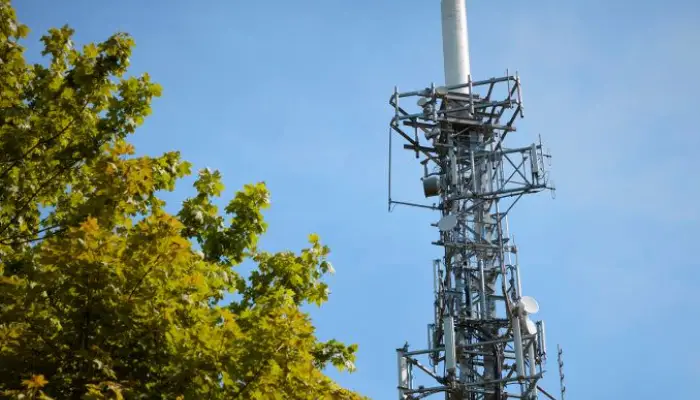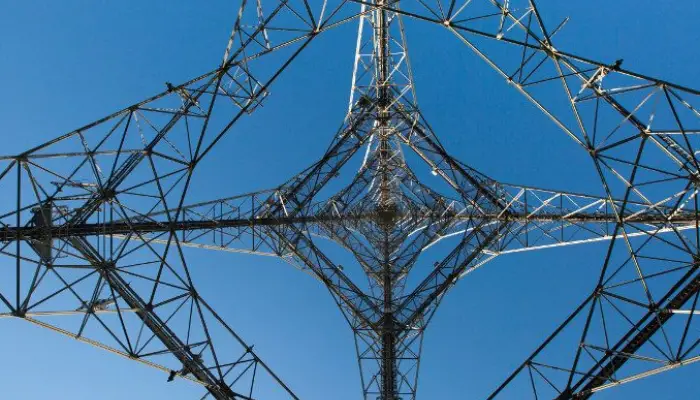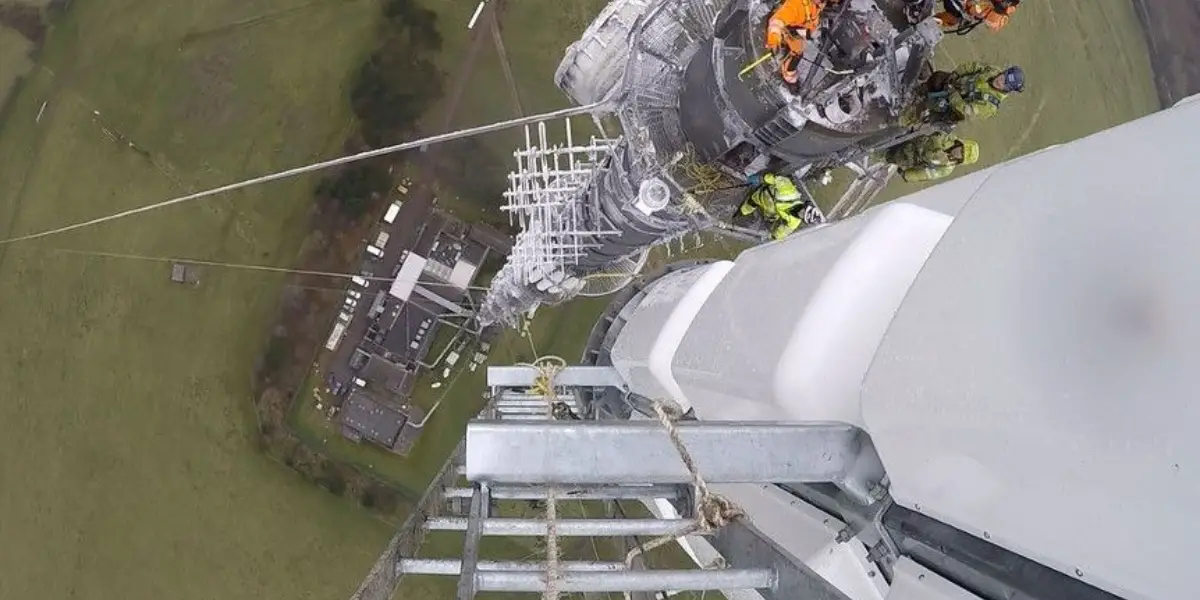A major re-engineering programme is now well underway with the objective of clearing the 700MHz frequency band (UHF channels 49-60) of Digital Terrestrial Television (DTT) services by May 2020, to make spectrum available for future mobile data services.
You may be forgiven for thinking that the 700MHz project is just another Digital Switchover (DSO) programme in which we successfully converted the transmitter network from the pre-existing Analogue TV and Low Power Digital TV network to a High Power Digital network between 2008 and 2012. However, this is in many ways a more complex project.
The complexity of the 700MHz Clearance Programme
The requirement to alter transmission frequencies of high power DTT services has a direct impact on transmitter and the filtering systems required to allow transmission to take place. These components must be carefully modified, tested and commissioned to allow DTT signals to be transmitted on new frequencies.
Main Station antenna systems are significant engineering structures, often composed of very large Antenna Panels mounted at great heights on the top of a mast or around the mast or tower, which need careful installation and alignment to operate correctly. Whilst transportable systems can be used to minimise impact on services whilst station retuning takes place on the ground, modification of antenna systems can have significant implications.
DTT signals from individual transmitter sites have used between 3 to 8 closely grouped channels and, across the entire country, this has allowed all channels (from channel 21 to channel 60) to be used. Due to limitations of antenna performance, and to provide the required coverage in the most economical way, DTT transmit antenna have traditionally been optimised for use over the required grouping of channels from each station – please see “Broadcast Antennas – A Potted History” below.
Subsequently, the requirement to clear the 700MHz spectrum band and cause DTT channels to be retuned – sometimes with significant changes in frequency – leads to a situation where antennas need to be modified or replaced. This, coupled with the traditional limitation of antennas (ie. their operation over a limited band of channels) would have led to a difficult situation. Antennas would need to be replaced for post 700MHz operations prior to being retuned and these new antennas would not have been able to support transmission of services on their pre-clearance allocations.
Main Stations do have main and reserve antennas, this would have led to a situation where one antenna would have been able to operate on the ‘pre-clearance’ channels and the other on the ‘post-clearance’ channels. However, during this period where two ‘banded antennas’ would have been in place, with no reserve antenna, failure could lead to loss of service - an obviously unacceptable situation for both broadcasters and their viewers.
Reducing complexity and minimising impact on viewers
The DTT platform remains the most watched TV platform in the UK, and as such the number one priority for delivering the 700 MHz Clearance Programme is to minimise any impact on viewers. So, finding solutions to reduce the complexity of the Programme and help minimise any impact to viewers is high on the agenda.
Early in the development of the 700MHz Clearance plans the amount of work and infrastructure required appeared to be growing and growing. It was envisaged that 20 temporary masts would be required at Main Stations along with many more temporary transmitting antennas. The time and cost of implementing all of this infrastructure started to look like an obstacle to the Programme’s success.
Construction of temporary masts is a complex, time consuming and expensive process but one that would have been necessary to avoid the potential risks to service arising from the limitations of traditionally banded antennas.
The birth of the ‘broadband’ antenna idea
To overcome this situation, our engineers started to consider ways whether a non-banded or ‘broadband’ antenna could be designed to alleviate this situation. The installation of such an antenna would allow both pre- and post-Clearance channels to be accommodated. This would also make it possible to avoid loss of antenna redundancy (except during the relatively short period of each antenna installation) and, most significantly, reduce the requirement for temporary masts. This type of solution would significantly minimise the scope and complexity of the programme and increase the likelihood of achieving Clearance by May 2020.
Our engineers first discussed the concept of Broadband antennas with potential suppliers at the International Broadcasting Convention in 2015. The initial reaction was as expected; limitations of panel technology and physics was cited as the reason why an antenna with acceptable performance over the entire channel range (21 -60) could not be achieved. At that time, it seemed that either compromised antenna resilience or a significant number of temporary masts were inevitable.
However, the idea was not dead. Our antenna suppliers started to develop ideas and soon realised the difficulty of the task - particularly because the time did not seem to be available to try, test and develop a product that could be deployed to meet the timescale requirements of the 700MHz Clearance Programme.
After eliminating several potential solutions, Sira came up with the seed of an idea which might just solve the problem. They worked with the University of Milan to develop an Innovative Broadband antenna solution with theoretically astounding performance. A prototype was constructed and range tested at the Sira facility near Milan and the measured results perfectly matched the theoretical analysis – the Broadband antenna had become a reality.
An Arqiva inspired innovative solution
This innovation has significantly changed the scope and complexity of the 700MHz Clearance Programme. The advent of the broadband antenna allows support of both pre- and post-clearance transmissions on a single antenna and avoids prolonged periods of compromised antenna resilience, minimising risk to DTT services and reducing the requirement for temporary masts.
The first Sira Broadband antenna has recently been successfully put into operation at Mendip and AlanDick, Kathrein and RFS have also now developed their own products. We’re proud to have inspired this innovation, and grateful to our suppliers who have helped advanced antenna technology which, in turn, has significantly simplified the 700MHz Clearance Programme. As we enter an important stage of the project, we will continue to look at and develop innovative solutions to aid the successful delivery of this critical national infrastructure programme.
Broadcast antennas – a potted history
If we roll back the clock by as little as 40 years, the TV world was very different. High power broadcast on UHF frequencies was still relatively new and the idea of stations having to change channels would probably have got the response “why would they”? Depending on which side of 40 years you roll there were only 2, 3 or 4 analogue TV channels available. Viewers still marvelled at the pictures and considered it somewhat magical; the occasional blip on the picture or loss of service didn’t really cause anyone to complain too much.
The antennas used during these times were very much new technology, albeit some of the parts looked like they would be more at home in a steam engine boiler. Analogue TV signals were quite unforgiving; the powers were high, making things run hot; if the antenna was not tuned finely enough some of the picture signal would bounce around in the system and lead to ghosts on screen; and the computing power available to aid design would now be considered embarrassingly low; even in your watch or phone. Despite all this, some very clever people (many in the BBC and Independent Broadcasting Authority it must be said) managed to create a network that we all grew to love; more and more each year.
The UK was at the forefront of this, as has often been the case; but we were by no means the only players. Other countries also had their experts and their systems evolved and created their own networks. Whilst the technology was similar, the actual network requirements were different. For example, in the UK, the use of a single antenna and structure to transmit all services was a must; whereas in the USA every station had its own structure and antenna, with maybe a reserve structure on an adjacent hill, leaving large aerial farms.
Demands from customers have resulted in broadcast antenna suppliers adapting their designs to meet new challenging requirements. The evolution of new antennas can be seen to follow the changes in broadcast technology.
During the analogue era the antenna components used became more and more standard, however the antenna systems themselves remained bespoke; whilst some broadband systems were available the performance was not really adequate. By the time Channel 5 and low power DTT were being built in the second half of the 1990’s broadband components were widely in use; however the specific complex antenna requirements meant the systems used were narrow band. The very bespoke antenna pattern requirements along with rapidly improving computer power did result in significant improvements in modelling during this period.
During the noughties, low power DTT gave way to the start of full scale DSO; meaning channel changes across most of the network; and many new antennas; partly due to the changing channels but also because of the additional requirement for reserve systems at main stations.
Broadcast antenna suppliers have always had the dream of standard products, which really means ‘broadband’; but with no market requirement and limited computing resources they remained at best a dream, many believing the laws of physics prevented them working anyway – until now.
Views

700MHz Clearance: A focus on airworks

700MHz Clearance: Filling the gaps

What is 700MHz Clearance?
